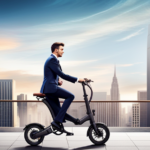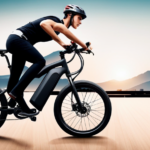Do you ever find yourself stuck in traffic, frustrated by the never-ending gridlock?
Imagine a different way to commute, where you effortlessly glide past the cars, feeling the wind in your hair and the thrill of freedom.
With an electric bike, your daily commute can become a joyous adventure, allowing you to travel farther than you ever thought possible.
In this article, we will explore just how far you can commute on an electric bike and reveal the secrets to maximizing your range.
Get ready to revolutionize your daily journey!
Key Takeaways
- Factors such as weight of the rider, headwinds, maximum assist level, and battery usage optimization affect the range of an electric bike.
- Electric bikes offer cost-effective commuting compared to cars and promote a healthier lifestyle while being environmentally friendly.
- Safety considerations such as wearing appropriate gear, following traffic rules, and practicing safe riding habits are important for electric bike commuting.
- Embracing electric bike commuting can prioritize safety, provide a convenient and eco-friendly mode of transportation, reduce traffic congestion, and promote a healthier lifestyle while reducing environmental impact.
Understanding Electric Bike Range
The range of an electric bike depends on factors such as battery capacity and terrain. Assessing battery capacity is crucial in determining how far you can commute on an electric bike. A higher battery capacity will provide a longer range, allowing you to travel greater distances before needing to recharge.
However, other factors can also affect electric bike range. Terrain plays a significant role, as hilly or rough terrains can drain the battery faster compared to flat surfaces. Additionally, your riding style, speed, and weight can impact the range.
To assess your commute distance, consider the battery capacity of your electric bike and the terrain you will be riding on. By understanding these factors, you can estimate how far you can comfortably commute on your electric bike.
Transitioning into the subsequent section, let’s now explore different methods for assessing your commute distance.
Assessing Your Commute Distance
Calculate your travel distance by determining the length of your daily journey. Evaluating efficiency is crucial in understanding how far you can commute on an electric bike.
To assess your commute distance, consider the following factors:
- Terrain: Uphill climbs will drain your battery faster than flat roads.
- Riding style: Riding at a higher speed or using the motor more frequently will decrease your battery range.
- Weather conditions: Strong headwinds or extreme temperatures can impact battery performance.
- Payload: Carrying heavy loads will require more power and reduce your range.
- Battery capacity: Calculate the capacity of your electric bike’s battery to estimate the distance it can cover.
By considering these factors and calculating battery capacity, you can determine the approximate distance you can commute on an electric bike.
Transitioning into the subsequent section about ‘types of electric bikes,’ it’s crucial to choose a bike that aligns with your commute requirements.
Types of Electric Bikes
When it comes to electric bikes, there are three main types to consider.
First, there are Class 1 pedal-assist electric bikes, which provide assistance when you pedal, but only up to a certain speed.
Second, there are Class 2 throttle-assist electric bikes, which allow you to control the speed with a throttle, without the need to pedal.
Lastly, there are Class 3 speed pedelec electric bikes, which offer pedal assistance up to higher speeds, making them ideal for longer commutes.
Each type has its own benefits and considerations, so it’s important to choose the one that best suits your needs.
Class 1: Pedal-Assist Electric Bikes
You can easily ride a Class 1 pedal-assist electric bike for a long distance without getting tired. These bikes are equipped with pedal assist technology, which means that as you pedal, the electric motor provides an extra boost to your efforts. This not only helps you cover more ground with less effort, but it also extends the battery life of the bike.
With a Class 1 electric bike, you can commute to work, run errands, or explore your city without worrying about getting exhausted. The pedal-assist feature allows you to maintain a steady pace and tackle hills or headwinds with ease.
As you transition into the next section about Class 2 throttle-assist electric bikes, you’ll discover another exciting option for your daily commute.
Class 2: Throttle-Assist Electric Bikes
Ready to explore an alternative to pedal-assist electric bikes? Get ready for the convenience and power of Class 2 throttle-assist electric bikes.
These bikes provide a different riding experience, as they are equipped with a throttle that allows you to control the speed without pedaling. This feature comes in handy when you need a quick burst of power or simply want to take a break from pedaling.
When it comes to bike maintenance, Class 2 bikes are fairly low-maintenance, requiring regular check-ups and occasional adjustments. However, the most important aspect to consider is the battery life. It’s crucial to ensure that the battery is fully charged before each ride to maximize your commuting distance.
Looking for even more speed and power? Let’s dive into the next section about Class 3 speed pedelec electric bikes.
Class 3: Speed Pedelec Electric Bikes
If you’re looking for more speed and power, Class 3 speed pedelec electric bikes are the way to go. These electric bikes are designed to assist you in achieving higher speeds, with a top speed of up to 28 miles per hour.
However, it’s important to note that there are certain electric bike speed limits and legal requirements for Class 3 electric bikes. In most areas, riders must be at least 16 years old and wear a helmet when operating a Class 3 electric bike. Additionally, some regions may require riders to have a valid driver’s license.
It’s crucial to familiarize yourself with the specific regulations in your area before riding a Class 3 electric bike. By understanding and adhering to these legal requirements, you can safely enjoy the increased speed and power that Class 3 electric bikes offer.
Now, let’s explore how you can maximize your electric bike range.
Maximize Your Electric Bike Range
To maximize your electric bike range, it’s important to consider factors such as terrain and battery capacity. Increasing battery life can be achieved by optimizing power usage. This means being mindful of how much power you’re using and finding ways to conserve it.
One way to do this is by using pedal assist instead of relying solely on the motor. By pedaling along with the motor, you can decrease the amount of power needed and extend your range. Another tip is to avoid using the highest level of assistance unless absolutely necessary, as it consumes more power.
Additionally, maintaining a steady speed and avoiding sudden accelerations can also help conserve battery life. By implementing these strategies, you can maximize your electric bike range and enjoy longer rides.
Now, let’s move on to the next section about charging your electric bike.
Charging Your Electric Bike
When it comes to charging your e-bike, it’s important to know the best practices for maintaining and extending the battery life. Here are some tips for maximizing your electric bike battery life:
- Use the correct charger: Make sure to use the charger that came with your e-bike, as using a different one could damage the battery.
- Avoid overcharging: Once your battery is fully charged, unplug it from the charger to prevent overcharging, which can reduce battery life.
- Store your battery properly: If you won’t be using your e-bike for an extended period, store the battery in a cool, dry place to prevent degradation.
- Charge at the right temperature: Extreme temperatures can affect battery performance, so charge your e-bike in a temperature-controlled environment.
- Avoid deep discharges: Try to keep your battery charged above 20% to prevent deep discharges, which can shorten its lifespan.
By following these tips, you can ensure that your electric bike battery lasts longer and provides you with maximum range.
Speaking of range, let’s now explore some examples of how far you can commute on an electric bike.
Electric Bike Range Examples
Let’s now explore some examples of how long an e-bike can travel on a single charge. The electric bike battery life can vary depending on several factors affecting electric bike range. These factors include terrain, rider weight, wind resistance, and assist level. To give you an idea of the range, here are some examples of electric bike range based on different conditions:
| Example | Distance (miles) |
|---|---|
| City commuting | 20 |
| Hilly terrain | 15 |
| Rider weight 220 lbs | 25 |
| Strong headwinds | 18 |
| Maximum assist level | 30 |
As you can see, the range can fluctuate based on various factors. In the next section, we will discuss ways to extend your electric bike range without compromising your travel needs.
Extending Your Electric Bike Range
Extending your e-bike range can be achieved by implementing certain strategies. One of the most important factors in maximizing your battery life is optimizing its usage. This can be done by avoiding frequent acceleration and braking, as well as keeping a consistent speed.
Additionally, efficient route planning can greatly contribute to extending your range. By choosing the most direct and flat routes, you can minimize the energy expended on climbing hills and maneuvering through traffic. Taking advantage of bike lanes and avoiding congested areas can also help conserve energy.
By implementing these strategies, you can significantly increase the distance you can commute on your electric bike. This increased range not only allows for longer rides, but it also expands the potential benefits of electric bikes for commuting, such as reducing carbon emissions and saving on transportation costs.
Benefits of Electric Bikes for Commuting
Now that you know how to extend your electric bike range, let’s talk about the benefits of electric bikes for commuting.
Electric bikes offer several advantages over cars when it comes to commuting. Firstly, electric bikes are a much more cost-effective option compared to cars. They are significantly cheaper to purchase and maintain, with lower fuel and insurance costs.
Secondly, electric bikes are environmentally friendly. They produce zero emissions, helping to reduce air pollution and combat climate change.
Lastly, electric bikes provide a healthier and more active commute. By pedaling on your electric bike, you can improve your fitness level and enjoy the outdoors while commuting.
- Electric bikes are more cost-effective than cars.
- Electric bikes are environmentally friendly.
- Electric bikes promote a healthier lifestyle.
Now, let’s delve into the safety considerations for electric bike commuting.
Safety Considerations for Electric Bike Commuting
To ensure a safe commute on your electric bike, it is important to consider certain safety factors. Electric bike safety should be a top priority for any commuter. One of the most crucial aspects of electric bike safety is wearing the appropriate safety gear. This includes a properly fitted helmet, reflective clothing, and sturdy shoes. Wearing a helmet can protect your head in case of an accident, while reflective clothing increases your visibility to other road users.
Additionally, it is important to follow all traffic rules and signals, as well as be aware of your surroundings at all times. By practicing safe riding habits and wearing the necessary safety gear, you can greatly reduce the risk of accidents while commuting on your electric bike.
Transitioning into the subsequent section about ‘conclusion: embracing electric bike commuting’:
Embracing electric bike commuting not only offers a convenient and eco-friendly way to travel, but it can also be done safely with the right precautions.
Conclusion: Embracing Electric Bike Commuting
Embrace the benefits of electric bike commuting by prioritizing safety and enjoying a convenient and environmentally friendly mode of transportation. Electric bike commuting is an emerging trend that offers numerous advantages. Not only does it help reduce traffic congestion, but it also promotes a healthier lifestyle and reduces the environmental impact of traditional transportation methods. By adopting electric bike commuting, you can contribute to a cleaner and greener environment.
To fully embrace electric bike commuting, it is essential to prioritize safety. Always wear a helmet, use designated bike lanes whenever possible, and be aware of your surroundings. Additionally, consider investing in safety accessories such as lights and reflective clothing to increase visibility. By taking these precautions, you can ensure a safe and enjoyable commuting experience.
Embracing electric bike commuting also means acknowledging the environmental impact of your transportation choices. By opting for an electric bike instead of a car, you significantly reduce carbon emissions and air pollution. This small change can have a big impact on the overall health of the planet.
In conclusion, electric bike commuting is an excellent way to embrace emerging trends while minimizing your environmental footprint. By prioritizing safety and being mindful of the environmental impact, you can fully enjoy the benefits of electric bike commuting. So, hop on your electric bike and start exploring a new way to commute!
Frequently Asked Questions
Can I use an electric bike for long-distance commuting, such as traveling between cities?
Yes, you can use an electric bike for long-distance commuting between cities. Electric bike range and the benefits of electric bike commuting make it a viable option for such travel.
Are there any limitations or challenges when using an electric bike for commuting in hilly or mountainous areas?
When riding an electric bike in hilly or mountainous areas, there are limitations to consider. Steep inclines can drain the battery quickly, so it’s essential to choose a bike with sufficient power and consider using lower gears to tackle the hills effectively.
How does the weight of the rider and cargo affect the range of an electric bike?
The weight of the rider and cargo has a significant effect on the range of an electric bike. Heavier weights require more power, reducing the distance that can be traveled. Additionally, hilly or mountainous terrain further decreases the range.
Can I still ride my electric bike if the battery runs out of charge?
If your electric bike runs out of charge, don’t worry! You can still ride it, just like a regular bike. However, if you need to charge it, consider alternative ways like using a portable charger or finding a charging station.
Are there any regulations or restrictions on using an electric bike for commuting, such as speed limits or bike lane access?
There are speed limit regulations for electric bikes, typically capped at 20 mph. Bike lane access restrictions vary by location, but many cities allow electric bikes in bike lanes as long as they follow the speed limits.
Conclusion
So there you have it, the truth about how far you can commute on an electric bike.
After investigating various factors such as battery capacity, terrain, and speed, it is clear that electric bikes can take you quite a distance.
With the right bike and proper charging habits, you can easily cover 20-40 miles on a single charge.
However, don’t forget to consider safety precautions and always be aware of your surroundings.
So why wait? Embrace electric bike commuting and enjoy a convenient and eco-friendly way to travel.
















